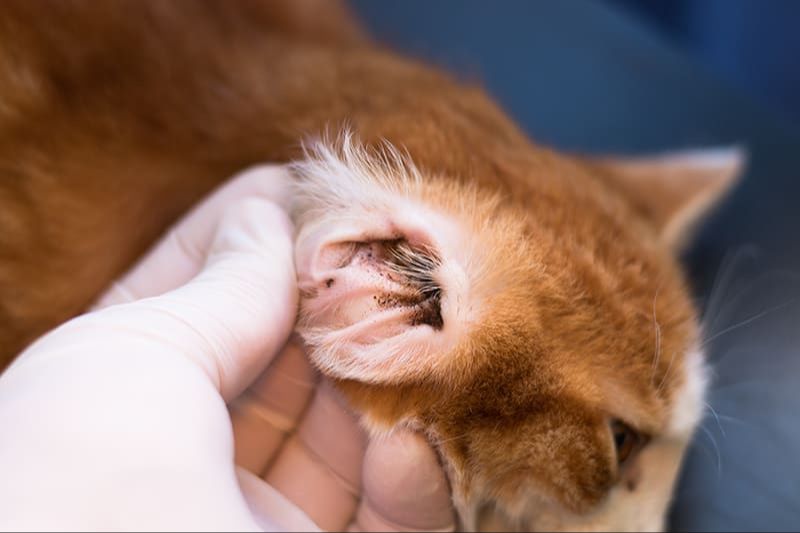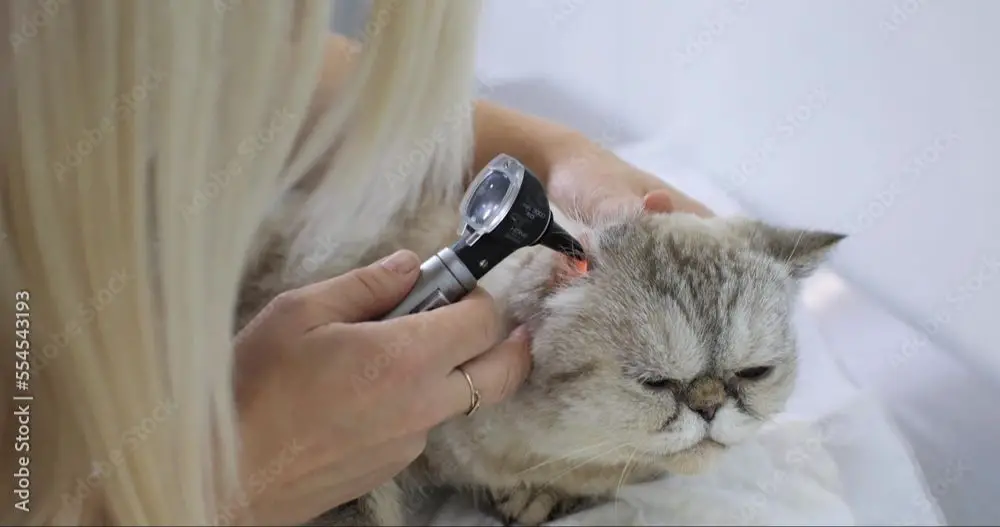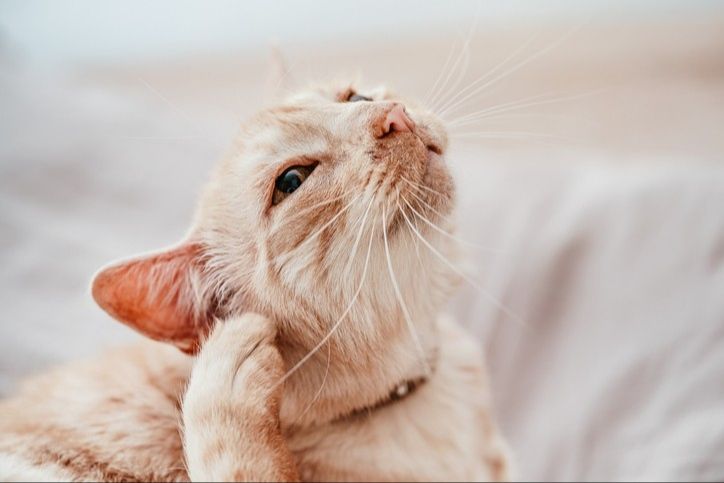Ear infections, known medically as otitis externa or media, are a common health problem for cats. They involve inflammation and infection of the external or internal ear canal. Studies show that around 20-30% of cats visiting the vet have some form of ear infection.
Ear infections have multiple potential causes, including bacteria, fungi, mites, foreign objects, trauma, tumors, and allergies. Symptoms can include odor, discharge, redness, swelling, head shaking, scratching at the ears, balance issues, and hearing loss. While some mild cases may resolve on their own, most require diagnosis and treatment by a veterinarian to prevent the infection worsening or causing permanent damage.
Causes
Ear infections in cats are often caused by an overgrowth of bacteria or yeast in the ear canal. Some common causes include:

-
Bacteria – Bacteria like Staphylococcus, Pseudomonas, and Proteus can overgrow in the ear canal, especially if it is damaged or inflamed.
-
Yeast – An overgrowth of yeast like Malassezia is another common cause of feline ear infections.
-
Ear mites – The mite Otodectes cynotis is a parasite that can infect cat’s ears and cause inflammation and infection.
-
Allergies – Allergies to foods, environmental factors, or other substances can cause inflammation and infection of the ears.
-
Foreign objects – Things like grass seeds getting lodged in the ear canal can obstruct it and lead to infection.
A combination of factors like allergies, ear mites, and bacterial overgrowth often contribute to chronic or recurring ear infections in cats.
Symptoms of Cat Ear Infections

The most common symptoms of an ear infection in cats include head shaking, scratching or rubbing of the ears, foul odor coming from the ears, and discharge from the ears. Discharge is often the first noticeable sign and may initially look like dark brown wax. As the infection progresses, the discharge can become yellow, bloody, or purulent (containing pus).
Other symptoms include:
- Vigorous head shaking and scratching, sometimes to the point of self-mutilation
- Redness and swelling inside the ear
- Scabs around the outside of the ear
- Loss of balance or equilibrium
- Foul odor coming from the ears
- crusty debris in or around the outer ear
- Hearing loss
If your cat is exhibiting any of these symptoms, it’s important to get them checked out by a veterinarian as soon as possible. Left untreated, ear infections can lead to ruptured eardrums, damage to the inner ear, and even deafness. In severe cases, the infection can spread to the nervous system.
Diagnosis
If you suspect your cat may have an ear infection, the first step is to take them to the vet for a professional diagnosis. The vet will start with a general physical exam, checking your cat’s ears, eyes, mouth, skin, and body temperature for any signs of infection.
The key diagnostic tool for ear infections is an otoscopic exam. The vet will use an otoscope, which is an instrument with a light and magnifying lens, to look inside your cat’s ear canal. This allows the vet to visually inspect the ear canal and eardrum for redness, inflammation, discharge, growths, foreign objects, and other issues.
The vet will also take a sample of the discharge or debris from your cat’s ear using a cotton swab. This sample can be looked at under the microscope and cultured to identify the specific bacteria or yeast causing the infection. Identifying the organism helps determine the most effective medication for treatment.
References:
https://www.vscot.com/site/blog/2021/04/15/ear-infection-cats
https://vcahospitals.com/know-your-pet/ear-infections-in-cats-otitis-externa
Treatment

Treatment for cat ear infections focuses on resolving the underlying cause and may involve antibiotics, antifungals, corticosteroids, flushing the ear canal, or in severe cases, surgery.
Antibiotics like amoxicillin and cephalexin are commonly prescribed for bacterial infections. They work by stopping the growth and spread of bacteria. The typical course is around 2-4 weeks (https://www.petmd.com/cat/conditions/ears/8-steps-treating-cat-ear-infections).
Antifungal medications such as miconazole and ketoconazole are used for fungal infections. These inhibit fungus growth and clear up the infection. Complete recovery can take several weeks (https://www.webmd.com/pets/cats/ear-infections-in-cats-causes-treatment-and-prevention).
Corticosteroids like hydrocortisone help reduce inflammation and itching. They provide relief while other treatments address the underlying infection. Long-term use can have side effects, so vets carefully manage dosage (https://www.mooresvilleanimalhospital.com/site/blog/2021/02/28/ear-infection-in-cats).
Ear flushing physically removes debris, discharge, and excess wax buildup. This allows medication to better penetrate the infected area. Sedation may be required if the procedure is painful (https://www.petmd.com/cat/conditions/ears/8-steps-treating-cat-ear-infections).
Surgery like total ear canal ablation removes the entire ear canal. This is a last resort for chronic or severe infections that do not respond to other treatments (https://www.webmd.com/pets/cats/ear-infections-in-cats-causes-treatment-and-prevention).
Home Remedies
There are some home remedies that may help treat a cat’s ear infection. These should only be used after consulting with a veterinarian, as they may not be appropriate for all infections.
One home remedy is to gently clean the cat’s ears to remove debris and wax buildup. Use a cotton ball or pad dampened with a veterinarian-recommended ear cleaning solution. Wipe just the outer part of the ear, and avoid going deep into the ear canal. Be very gentle, as the ear is likely irritated.
Some people report success using dried oregano as a natural antibiotic for cat ear infections. You can buy dried oregano herb and finely crush it into a powder. Mix a pinch of oregano powder into a small amount of olive oil or coconut oil. Using an eyedropper or cotton swab, apply 2-3 drops of the oil mixture into the infected ear twice daily. The oregano may help combat the infection thanks to its antimicrobial properties (Source).
Apple cider vinegar is another popular home remedy. Mix equal parts vinegar and water, then put 2-3 drops in the cat’s ear. The acidic vinegar can help change the pH in the ear, making it more difficult for bacteria and yeast to thrive. Use this 1-2 times per day (Source).
Prevention
There are several ways to help prevent ear infections in cats:
Keep ears clean and dry. Gently clean the outer ear with a cotton ball dampened with a veterinarian-approved ear cleanser to remove debris and wax buildup. After baths or swimming, gently dry your cat’s ears with a soft towel or cotton ball. Excessive moisture can allow bacteria and yeast to grow.
Treat underlying allergies. Allergies are a common cause of chronic ear infections in cats. Work with your veterinarian to identify and treat any allergies your cat may have. This could involve a hypoallergenic diet, antihistamines, immunotherapy, or other allergy treatments.
Avoid foreign objects. Make sure your cat does not have access to small objects like beads, erasers, pins, etc., that could become lodged in the ear canal. Check your cat’s ears periodically for foreign material.
Regular veterinary checkups can also help catch early signs of infection. Your vet can examine your cat’s ears and provide preventative cleaning and medication if needed.
Prognosis
With proper diagnosis and timely treatment, the prognosis for ear infections in cats is generally good [1]. The majority of infections will resolve with medications and ear cleanings over the course of 1-4 weeks. However, ear infections can recur in some cats, especially if an underlying cause is not addressed. Recurrent or long-standing infections may result in permanent changes to the ear canal such as thickening, scarring, or calcification. Severe damage to ear structures is possible if infections are left untreated. But with attentive care from a veterinarian, most cats make a full recovery and do not experience long-term issues.
Key factors that determine prognosis include how quickly treatment is started, how severe the infection is, whether complications are present, and if an underlying condition can be identified and managed. Kittens, geriatric cats, and breeds with conformational ear issues tend to have higher recurrence rates. Overall though, with proper treatment tailor-made for the individual cat, full recovery is expected in the majority of cases.
When to See a Vet
You should bring your cat to a vet if their ear infection does not improve within 7-10 days of starting treatment at home. Chronic or severe infections often require prescription medication prescribed by a veterinarian to fully resolve. Signs that warrant an urgent vet visit include:
- No improvement after 7-10 days of home treatment
- Chronic, recurrent ear infections
- Loss of balance or trouble walking
- Head tilt or head shaking
- Bad odor or pus from the ears
- Scratching or rubbing the ears excessively
A vet can examine the ear canal with an otoscope to determine the cause and severity of the infection. They may collect a sample of the discharge to identify the type of bacteria or yeast involved. Treatment prescribed by a vet for stubborn infections may include prescription ear drops or oral medication. Prompt veterinary attention is advised if home remedies do not resolve the infection within 7-10 days.
Conclusion

In summary, ear infections are a common problem for cats but most resolve with proper treatment from a veterinarian. The infection usually develops from a buildup of wax, moisture, mites, bacteria or foreign objects in the ear canal. Symptoms include head shaking and scratching, discharge and odor. Treatment typically involves cleaning the ears, medication and may require surgery in severe cases. While most ear infections will go away with treatment, they can recur if the underlying cause isn’t addressed. Preventative care is essential. Keep your cat’s ears clean and dry, avoid foreign objects and check for signs of parasites. See your vet promptly if you notice symptoms of an ear infection in your cat.
